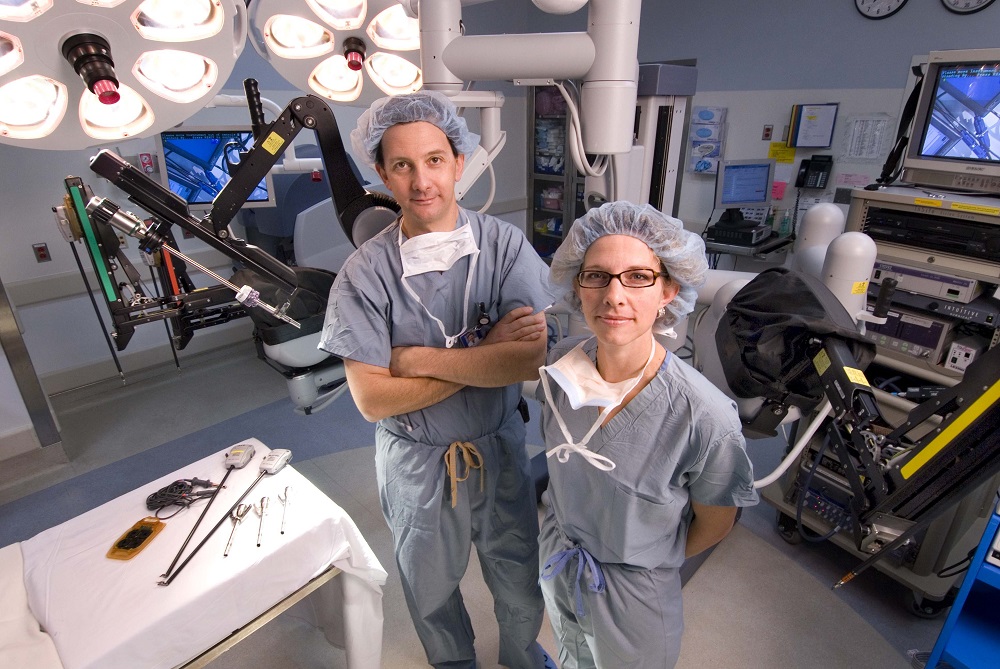Many associate cancer treatment with chemotherapy and radiation therapy, but for many women with gynecologic cancers, surgery is often the first line of defense. Colleen Feltmate, MD, director of minimally invasive surgery in gynecologic oncology at Dana-Farber/Brigham and Women’s Cancer Center (DF/BWCC), shares insight into surgical options to treat these cancers.

Minimally Invasive vs. Open Surgeries
Minimally invasive surgery, or laparoscopy, is increasingly used in gynecologic cancers, often with the assistance of a robot. Robotic surgery can give surgeons improved control and precision during intricate procedures, and requires only a few small incisions, as opposed to larger, open surgeries.
Minimally invasive procedures, with or without robotic assistance, can reduce hospital and recovery time, and often cause less pain post-surgery. Feltmate and colleagues in Dana-Farber’s Susan F. Smith Center for Women’s Cancers recently published a study in the Annals of Surgical Oncology showing that patients who underwent laparoscopic hysterectomies and were discharged the same day did not experience increased post-operative complications. Patients who have open surgeries using a larger incision generally stay 3-4 days in the hospital and have a recovery period of up to six weeks.
For endometrial (uterine) cancer, the most common gynecologic cancer, the vast majority of patients are eligible for minimally invasive surgery to remove the uterus, cervix, fallopian tubes, and/or ovaries through a small incision. But this approach may not be right for all gynecologic cancer patients.
“There are a number of medical or anatomical reasons why minimally invasive surgery may not be used,” Feltmate notes. These include the uterus being too large to remove in one piece; previous abdominal or pelvic surgery; past chemotherapy or radiation treatment; or intolerance to carbon dioxide, which is used to expand the abdomen during laparoscopic procedures. Open surgery may also be required depending on the cancer and its stage. Women with ovarian cancer in particular are more likely to be treated with an open surgery, as they are often diagnosed in later stages when the cancer has spread.
Read More:
Sentinel Node Biopsies
“The goal of gynecologic surgeries is always to take out less,” says Feltmate. One way surgeons do this is through sentinel node biopsies, which use dyes to locate and remove lymph nodes where the cancer has spread to prevent unnecessary node removal and additional surgeries. This strategy is often used in vulvar cancer and increasingly in endometrial and cervical cancers.
Sentinel node biopsies also help prevent lower leg swelling, which can happen when lymph nodes are removed during gynecologic surgery, Feltmate says.
Preventative Surgeries
With increased attention on the connection between mutated genes and cancer, there has been an influx in prophylactic (preventative) gynecologic surgeries, says Feltmate. Women like actress Angelina Jolie who test positive for the BRCA-1 or BRCA-2 genes may decide to undergo a preventative salpingo-oophorectomy to remove the ovaries and fallopian tubes. These genes increase a woman’s lifetime risk of ovarian cancer to 20-40 percent, a jump from the 2 percent risk among the general population. Another familial condition, Lynch syndrome, which causes polyps or pre-cancers to develop in the colon or uterus earlier than in the general population, puts women at an increased risk of endometrial and ovarian cancers, and some may elect to have a preventative hysterectomy. Speaking with a genetic counselor can help women understand the risks and benefits of preventive surgery.

“These genes increase a woman’s lifetime risk of ovarian cancer by 20-40 percent.” This is not correct. The lifetime risk is increased TO 20-40%, not increased BY 20-40% (compared to the general population risk which is less than 2%). For the risk to go from 2% to 20%, it is increased by 1000%.
Dear Amanda – Thank you for catching that and bringing it to our attention. We have updated the post to properly reflect the increased risk. Wishing you all the best. – DFCI